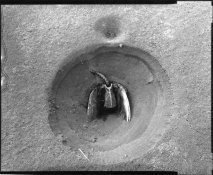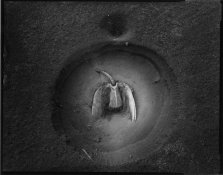It can be tough, if not impossible, to get a lot of expansion into a neg that is shot in *totally* flat conditions. Additionally, sharp detail can be hard to render in these situations, due to the totally even and diffused light everywhere. Therefore even if you tweak things to add more contrast, it can look rather odd in the end, with very flat dark areas of the print. No matter how much contrast you add or remove, you are still stuck with the basic quality of light that existed at the scene. So, it would probably be best to really think long and hard about how you want to render the scene, keeping in mind that no matter what you do, you will not get the ultra-sharp, ultra detailed look that comes from a certain quality of light that just cannot be present in a flat lighting situation. Every artist has a different idea of what he or she wants to print. I would personally think that this kind of scene would scream to be printed as a beautiful long-scaled midtoned print, giving up on the standard black-to-white print.
But as long as there is about three "stops" at the scene of exposure, you can get a somewhat "normal-looking" print if you are a good printer. What you want to do is make an exposure that will place the range of luminances at the scene (let's say three "stops" in this example) on a strip of your S curve that will allow you to add the most contrast with development and toning, then develop to N+2, if you can get there without introducing what you consider to be unacceptable levels of fog and grain (the larger the format the better, for this reason), and then tone the neg in a strong selenium bath to push it even farther.
When you make this exposure, however, you also have to consider where you want your last detail (III) and last texture (II) to be on the print. If you want texture on something, you don't want to place it below II. If you want detail, you don't want to place it below III. It would add the most contrast if you were to place the darkest luminance in the scene on zone 0 or I, but you would lose detail and texture at the expense of this contrast. It all comes down to where you want to make the compromises, as they cannot be avoided.
Personally, if I were shooting for a versatile negative in a scene with a range of luminances that was three "stops", this is what I would do:
1. Find the darkest area of the scene where I want texture on the print. Instead of placing this on zone II, I would place it on zone III, as I know for sure that I will have to print on a hard paper, which will push it down in printing. Having it on zone III will not maximize contrast index of the neg, because it moves the whole luminance range up the S curve. However, it will give you enough meat to manipulate the local contrast in this area via dodging and burning when you go to print. Like I said, it's a balancing act. Anything you do that is ideal for one effect will not be ideal for another.
2. This would make the highest luminance value at the scene fall on V. I know with my favorite zone system film, with a combination of development and toning, I can get darned near a net +3, which would have a zone V fall end up at a near zone VIII. So I would develop to N+2, which is as far as I have tested for, and then tone.
3. I would end up with a neg that should theoretically print from zones III to near-VIII with normal printing on my target paper, plus any shadow values that [hopefully] fell below those that I placed on III. However, the extreme development will also have raised the value of that zone III placement a bit. But that is OK, because this just means I can print on an even harder paper without losing that area.
All of this is assuming a wanted a fairly normal looking print, or at least just a versatile neg.
The reason I have had no problems getting to N+2, while others cannot, is that my target paper for my development testing is a grade 3, not a grade 2. I do this so I can either go up one grade or down one grade in printing, given the limited selection of grades now available. I like having the option of one grade below the target paper. This means that my normal development is flatter than is traditional, so my N+s are flatter as well. This means that what I call my N+2 is the same as what most would call N+1. If I tested for it, I bet I could get up to an N+2.5 (or maybe even N+3?) with development alone. I love HP5!







